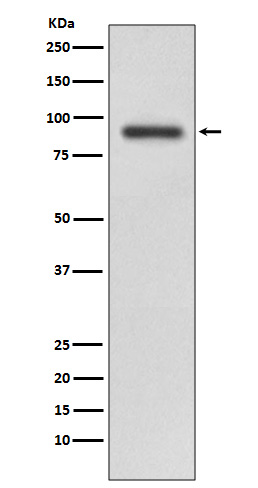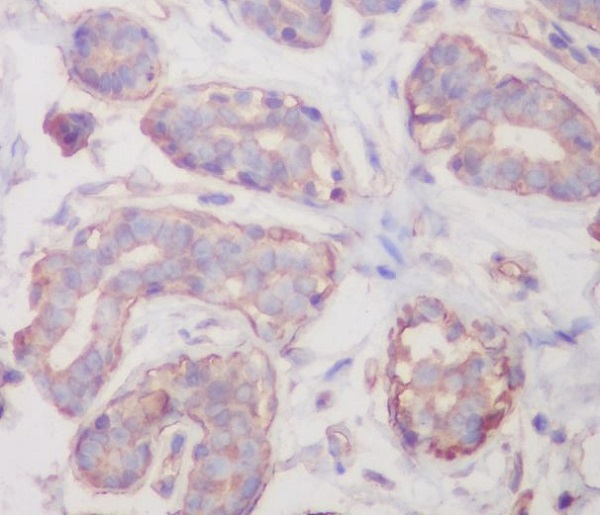

| WB | 1/1000-1/5000 | Human,Mouse,Rat |
| IF | 咨询技术 | Human,Mouse,Rat |
| IHC | 1/100-1/200 | Human,Mouse,Rat |
| ICC | 技术咨询 | Human,Mouse,Rat |
| FCM | 1/20-1/100 | Human,Mouse,Rat |
| Elisa | 咨询技术 | Human,Mouse,Rat |
| Aliases | RALBP1; RIP1; RLIP1; RLIP76;;RalBP1 |
| WB Predicted band size | Calculated MW: 76 kDa ; Observed MW: 95 kDa |
| Host/Isotype | Rabbit IgG |
| Antibody Type | Primary antibody |
| Storage | Store at 4°C short term. Aliquot and store at -20°C long term. Avoid freeze/thaw cycles. |
| Species Reactivity | Human,Mouse,Rat |
| Immunogen | A synthesized peptide derived from human RalBP1 |
| Formulation | Purified antibody in PBS with 0.05% sodium azide,0.05% BSA and 50% glycerol. |
+ +
以下是关于RALBP1抗体的3篇参考文献,按作者和摘要内容简要概括:
1. **文献名称**: "RLIP76. a transporter of glutathione conjugates and xenobiotics"
**作者**: Awasthi S, et al.
**摘要**: 该研究通过Western blot和免疫组化分析,证实RALBP1(RLIP76)作为GSH结合转运蛋白的功能。使用特异性抗体发现其在多种癌细胞中高表达,并参与化疗药物外排,与多药耐药性相关。
2. **文献名称**: "RALBP1 regulates exocytosis and EGFR signaling in non-small cell lung cancer"
**作者**: Yin MB, et al.
**摘要**: 利用RALBP1抗体进行免疫沉淀和共聚焦显微术,发现其在非小细胞肺癌中调控EGFR内吞及下游MAPK通路激活,敲低RALBP1可抑制肿瘤生长并增强顺铂敏感性。
3. **文献名称**: "Immunohistochemical detection of RALBP1 in glioblastoma progression"
**作者**: Ceresa BP, et al.
**摘要**: 通过组织芯片和抗RALBP1抗体分析胶质母细胞瘤样本,发现其表达水平与肿瘤分级和血管生成正相关,提示其可作为预后标志物及治疗靶点。
RALBP1 (RALA Binding Protein 1), also known as RLIP76 or RIP1. is a multifunctional protein involved in cellular processes such as endocytosis, oxidative stress response, and drug resistance. It acts as a GTPase-activating protein (GAP) for RalA and RalB, small GTPases in the Ras superfamily, regulating vesicular trafficking and signal transduction. RALBP1 also functions as an ATP-dependent transporter, mediating the efflux of glutathione-conjugated electrophiles (GS-E), contributing to detoxification and chemoresistance in cancer cells. Its role in stress response links it to pathways like MAPK/ERK and PI3K/AKT, impacting cell survival and apoptosis.
RALBP1 antibodies are essential tools for studying its expression, localization, and interactions in various contexts. These antibodies enable detection via Western blotting, immunohistochemistry (IHC), and immunofluorescence (IF), helping researchers explore RALBP1's overexpression in cancers (e.g., lung, prostate, ovarian) and its association with aggressive tumor behavior and poor prognosis. Additionally, they aid in investigating RALBP1's involvement in neurodegenerative diseases, where oxidative stress mechanisms are implicated. Commercially available RALBP1 antibodies are typically raised in hosts like rabbit or mouse, targeting specific epitopes (e.g., N-terminal or C-terminal regions), and validated for cross-reactivity in human, mouse, or rat samples. Their applications extend to functional studies, such as siRNA knockdown validation or assessing therapeutic targeting in drug-resistant malignancies.
×